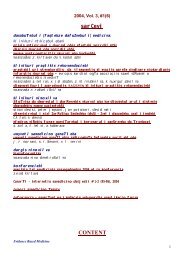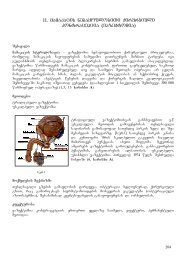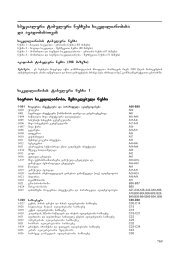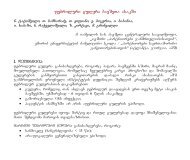aiv infeqcia/SidsiT avadmyofTa mkurnaloba da movla (klinikuri ...
aiv infeqcia/SidsiT avadmyofTa mkurnaloba da movla (klinikuri ...
aiv infeqcia/SidsiT avadmyofTa mkurnaloba da movla (klinikuri ...
Create successful ePaper yourself
Turn your PDF publications into a flip-book with our unique Google optimized e-Paper software.
of HIV-1 infection. The New England Journal of Medicine, 2004, 350(18):1850–1861.<br />
49. Staszewski S et al. Efavirenz plus zidovudine and lamivudine, efavirenz plus indinavir, and indinavir<br />
plus zidovudine and lamivudine in the treatment of HIV-1 infection in adults. Study 006 Team. The New<br />
England Journal of Medicine, 1999, 341(25):1865–1873.<br />
50. Bartlett JA et al. Abacavir/lamivudine in combination with efavirenz, amprenavir/ritonaviror stavudine:<br />
ESS40001 (CLASS) preliminary 48 weeks results. 14th International AIDS Conference, Barcelona,<br />
July 2002 (Abstract TuOrB1189).<br />
51. van Leeuwen R et al. A randomized trial to study first-line combination therapy with or without a protease<br />
inhibitor in HIV-1–infected patients. AIDS, 2003, 17(7):987–999.<br />
52. Calza L et al. Substitution of nevirapine or efavirenz for protease inhibitor versus lipid-lowering therapy<br />
for the management of dyslipi<strong>da</strong>emia. AIDS, 2005, 19(10):1051–1058.<br />
53. Sheran M. The nonnucleoside reverse transcriptase inhibitors efavirenz and nevirapine in the treatment<br />
of HIV. HIV Clinical Trials, 2005, 6(3):158–168.<br />
54. Palella FJ, Delaney KM, Moorman AC. Declining morbidity and mortality among patients with advanced<br />
human immunodeficiency virus infection. The New England Journal of Medicine, 1998,<br />
338:853–860.<br />
55. Perelson AS et al. HIV-1 dynamics in vivo: virion clearance rate, infected cell life-span, and viral<br />
generation time. Science, 1996, 271(5255):1582–1586.<br />
56. Mannheimer S et al. The consistency of adherence to antiretroviral therapy predicts biologic outcomes<br />
for human immunodeficiency virus-infected persons in clinical trials. Clinical Infectious Diseases,<br />
2002, 34(8):1115–1121.<br />
57. Fischl M et al. Impact of directly observed therapy on long-term outcomes in HIV clinical trials. 8th<br />
Conference on Retroviruses and Opportunistic Infections (CROI), Chicago, 4–8 February 2001 (Abstract<br />
528).<br />
58. Bangsberg DR et al. Adherence-resistance relationships for protease and non-nucleoside reverse<br />
transcriptase inhibitors explained by virological fitness. AIDS, 2006, 20(2):223–231.<br />
59. Maher K et al. Disease progression, adherence and response to protease inhibitor therapy for HIV infection<br />
in an Urban Veterans Affairs Medical Center. Journal of Acquired Immune Deficiency Syndromes,<br />
1999, 22(4):358–363.<br />
60. Vanhove GF et al. Patient compliance and drug failure in protease inhibitor monotherapy. JAMA, 1996,<br />
276(24):1955–1956.<br />
61. Little SJ et al. Antiretroviral-drug resistance among patients recently infected with HIV. The New England<br />
Journal of Medicine, 2002, 347(6):385–394.<br />
62. UK Collaborative Group on Monitoring the Transmission of HIV. Drug resistance. Analysis of prevalence<br />
of HIV-1 drug resistance in primary infections in the United Kingdom. BMJ, 2001, 322(7294):1087–<br />
1088.<br />
63. Bangsberg DR, Perry S, Charlesbois ED. Adherence to HAART predicts progression to AIDS. 8th<br />
Conference on Retroviruses and Opportunistic Infections (CROI), Chicago, 4–8 February 2001 (Abstract<br />
483).<br />
64. Lerner BH, Gulick RM, Dubler NN. Rethinking nonadherence: historical perspectives on triple-drug<br />
therapy for HIV disease. Annals of Internal Medicine, 1998, 129(7):573–578.<br />
65. Carrieri P et al. The dynamic of adherence to highly active antiretroviral therapy: results from the French<br />
National APROCO cohort. Journal of Acquired Immune Deficiency Syndromes, 2001, 28(3):232–239.<br />
66. Walsh JC et al. Reasons for non-adherence to antiretroviral therapy: patients’ perspectives provide<br />
evidence<br />
of multiple causes. AIDS Care, 2001, 13(6):709–720.<br />
67. Tuldra A et al. Prospective randomized two-arm controlled study to determine the efficacy of a specific<br />
intervention to improve long-term adherence to highly active antiretroviral therapy. Journal of Acquired<br />
Immune Deficiency Syndromes, 2000, 25(3):221–228.1-37 patient evaluation and antiretroviral treatment for adults and<br />
adolescents<br />
68. Bamberger JD et al. Helping the urban poor stay with antiretroviral HIV drug therapy. American Journal<br />
of Public Health, 2000, 90(5):699–701.<br />
69. Walsh JC et al. An assessment of current HIV treatment adherence services in the UK. AIDS Care,<br />
2002, 14(3):329–334.<br />
70. Cingolani A et al. Usefulness of monitoring HIV drug resistance and adherence in individuals failing<br />
highly active antiretroviral therapy: a randomized study (ARGENTA). AIDS, 2002, 16(3):369–379.<br />
71. Mannheimer S et al. The consistency of adherence to antiretroviral therapy predicts biologic<br />
outcomes for human immunodeficiency virus-infected persons in clinical trials.<br />
Clinical Infectious Diseases, 2002, 34(8):1115–1121.<br />
72. Chesney MA. Factors affecting adherence to antiretroviral therapy. Clinical Infectious Diseases, 2000,<br />
69

















